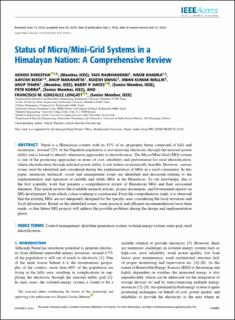| dc.contributor.author | Shrestha, Ashish | |
| dc.contributor.author | Rajbhandari, Yaju | |
| dc.contributor.author | Khadka, Nasib | |
| dc.contributor.author | Bista, Aayush | |
| dc.contributor.author | Marahatta, Anup | |
| dc.contributor.author | Dahal, Rojesh | |
| dc.contributor.author | Mallik, Jiwan Kumar | |
| dc.contributor.author | Thapa, Anup | |
| dc.contributor.author | Hayes, Barry P. | |
| dc.contributor.author | Korba, Petr | |
| dc.contributor.author | Gonzalez-Longatt, Francisco | |
| dc.date.accessioned | 2021-02-11T09:07:29Z | |
| dc.date.available | 2021-02-11T09:07:29Z | |
| dc.date.created | 2021-01-27T22:19:29Z | |
| dc.date.issued | 2020 | |
| dc.identifier.citation | Shrestha, A., Rajbhandari, Y., Khadka, N., Bista, A., Marahatta, A., Dahal, R., Mallik, J. K., Thapa, A., Hayes, B. P., Korba, P. & Longatt, F. M. G. (2020). Status of Micro/Mini-Grid Systems in a Himalayan Nation: A Comprehensive Review. IEEE Access, 8, 120983-120998. | en_US |
| dc.identifier.issn | 2169-3536 | |
| dc.identifier.uri | https://hdl.handle.net/11250/2727324 | |
| dc.description.abstract | Nepal is a Himalayan country with its 83% of its geography being composed of hills and mountains. Around 22% of the Nepalese population is not receiving electricity through the national power utility and is forced to identify alternative approaches to electrification. The Micro/Mini-Grid (MG) system is one of the promising approaches in terms of cost, reliability and performance for rural electrification, where electrification through national power utility is not techno-economically feasible. However, various issues must be identified and considered during the implementation of MGs in a rural community. In this paper, numerous technical, social and management issues are identified and discussed relating to the implementation and operation of reliable and stable MGs in the Himalayas. To our knowledge, this is the first scientific work that presents a comprehensive review of Himalayan MGs and their associated elements. This article reviews the available research articles, project documents, and Government reports on MG development, from which a clear roadmap is constructed. From the comprehensive study, it is observed that the existing MGs are not adequately designed for the specific area, considering the local resources and local information. Based on the identified issues, some practical and efficient recommendations have been made, so that future MG projects will address the possible problems during the design and implementation phase. | en_US |
| dc.language.iso | eng | en_US |
| dc.relation.uri | https://ieeexplore.ieee.org/document/9133062 | |
| dc.rights | Navngivelse 4.0 Internasjonal | * |
| dc.rights.uri | http://creativecommons.org/licenses/by/4.0/deed.no | * |
| dc.title | Status of Micro/Mini-Grid Systems in a Himalayan Nation: A Comprehensive Review | en_US |
| dc.type | Peer reviewed | en_US |
| dc.type | Journal article | en_US |
| dc.description.version | publishedVersion | en_US |
| dc.source.pagenumber | 120983-120998 | en_US |
| dc.source.volume | 8 | en_US |
| dc.source.journal | IEEE Access | en_US |
| dc.identifier.doi | https://doi.org/10.1109/ACCESS.2020.3006912 | |
| dc.identifier.cristin | 1880825 | |
| cristin.ispublished | true | |
| cristin.fulltext | original | |
| cristin.qualitycode | 1 | |

